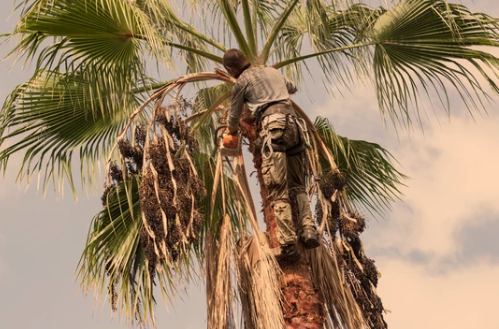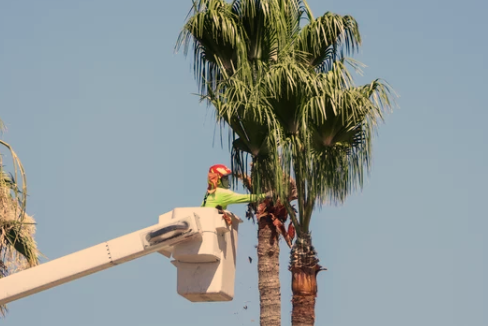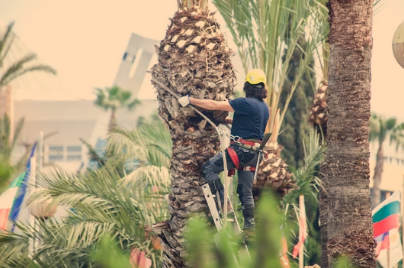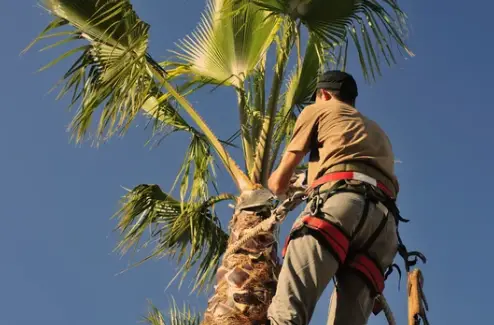Palm trees are iconic symbols of tropical and subtropical landscapes, adding grace and beauty to any environment.
Pruning palm trees is a vital aspect of their care, promoting their health, aesthetics, and overall safety.
However, knowing when and how to prune these majestic trees is essential to ensure successful results.
In this short blog post, we will delve into the intricacies of palm tree pruning, covering everything from understanding palm tree anatomy to the best pruning techniques.
By the end, you’ll have the knowledge and confidence to maintain your palm trees in their optimal state.
What are Palm Trees?

So, before we embark on the journey of pruning palm trees, it’s crucial to familiarize ourselves with their unique characteristics and growth habits.
Palm trees belong to the family Arecaceae and encompass numerous species, each with its own distinctive traits.
These trees typically have a single, straight trunk with a crown of large, feathery or fan-shaped fronds at the top.
Understanding the natural appearance and shape of palm trees is essential when pruning, as we aim to preserve their inherent beauty.
Signs that Indicate Pruning is Needed For Palm Tree

When to Prune Palm Trees
Pruning palm trees should be carried out purposefully and with specific indications in mind. Several signs suggest that it’s time to prune a palm tree.
Dead or Decaying Fronds:
Dead or decaying fronds are not only unsightly but can also pose a risk if they fall. Pruning these fronds not only improves the tree’s appearance but also eliminates potential safety hazards.
Diseased or Pest-Infested Fronds:
Fronds showing signs of disease or infestation should be promptly pruned to prevent further spread and to protect the overall health of the palm tree.
Overcrowding and Shading:
Overcrowded fronds can inhibit air circulation and sunlight penetration, leading to the decline of the tree’s health. Pruning away excess fronds helps maintain proper airflow and prevents the shading of healthy fronds.
Safety Concerns:
Low-hanging fronds or heavy fruit clusters can pose a risk to people and property. Pruning these fronds ensures the safety of those around the tree.
Palm Tree Pruning Guidelines

Now that we have identified the signs indicating the need for pruning, let’s delve into the guidelines for successful palm tree pruning.
Timing
Seasonal Considerations:
The timing of palm tree pruning is crucial to avoid detrimental effects on their growth.
Generally, the best time to prune palm trees is in late winter or early spring when the tree is dormant or entering its active growth phase.
However, it’s important to note that specific palm species may have different growth cycles, requiring adjustments to the pruning schedule.
Immediate Attention:
In certain situations, palm trees may require immediate attention. For instance, storm-damaged fronds or those posing an imminent safety risk should be pruned promptly.
It is recommended to seek professional arborists’ assistance for emergency pruning to ensure safety and proper handling of the situation.
Tools and Techniques
Essential Tools:
Pruning palm trees effectively requires a set of essential tools.
These include a pruning saw, loppers, hand pruners, gloves, safety goggles, and a ladder or pole saw for taller trees.
It’s crucial to use sharp, clean tools to minimize the risk of introducing diseases or causing unnecessary damage to the tree.
Step-by-Step Process:

Pruning palm trees follows a systematic approach to ensure the best results. Here is a step-by-step outline of the process:
Assess the Tree:
Begin by thoroughly assessing the palm tree. Identify the fronds that require pruning based on the signs mentioned earlier.
Removing Dead or Decaying Fronds:
Using a pruning saw, carefully remove dead or decaying fronds at their base, making a clean cut without damaging the trunk. Avoid cutting too close to the trunk as this can lead to trunk decay.
Cutting Diseased or Pest-Infested Fronds:
Similarly, for fronds affected by diseases or infestations, prune them at the base with a clean cut. Dispose of the pruned fronds appropriately to prevent further spread of diseases or pests.
Trimming Overcrowded or Shading Fronds:
Identify the green, healthy fronds that are causing overcrowding or shading. Prune these fronds selectively, removing only the necessary portions to maintain proper airflow and light penetration.
Care After Pruning:
Pruning is just the first step towards maintaining the health and vigor of palm trees. It’s crucial to provide post-pruning care to aid the tree’s recovery and minimize stress.
- Watering: After pruning, ensure that the palm tree receives adequate water to support its healing process. Water deeply and infrequently, allowing the soil to dry out slightly between waterings.
- Fertilization: Consider applying a balanced palm-specific fertilizer after pruning. This provides the necessary nutrients to support new growth and replenish any nutrients lost during the pruning process.
- General Maintenance: Continue to maintain regular care practices for your palm tree, such as removing weeds and maintaining a clean, mulch-free area around the trunk. Regularly inspect the tree for signs of pests, diseases, or any other issues that may require attention.
Summary
Pruning palm trees is a crucial aspect of their care, ensuring their health, aesthetics, and safety.
Knowing the signs that indicate pruning is needed, following proper timing, and utilizing the right tools and techniques, you can effectively maintain your palm trees in their optimal state.
Remember to prioritize regular pruning as a proactive measure to enhance the beauty and longevity of these iconic trees.
If uncertain about specific requirements or facing complex pruning tasks, it is always wise to seek professional advice or assistance.
With this comprehensive guide, you now have the knowledge and confidence to embark on your palm tree pruning journey.




